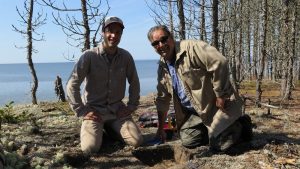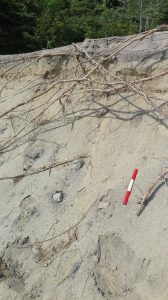2017 – The Archaeological Survey Resumes
Motivated by the 2016 results, the Archeo-Mamu archaeologists decided to resume their research the following year. A group of Innus was once again part of the group, among which Vanessa Copeau-Collard, who would not have missed this opportunity a second time! Many volunteers gave a hand to the group once again. As the shoreline had proven rich in artifacts, the team continued its research from the former year’s end point.
New clues
Artifacts were found in almost every pit the workers would dig. 182 artifacts were recovered on a superficy of 22 000m2. The majority of these pieces now were the results of an ancient First Nation presence, while 77 artifacts, among which a flintstone, were related to an Eurocanadian occupation during the 1800s, a fact already demonstrated by the digs of the previous summer.
It is worth mentioning that one of the pits showed traces of combustion, probably revealing an ancient campfire. This discovery was of very high interest because such fire pits are usually found in the center of First Nation’s dwellings. A few artifacts, among which indigenous ceramic sherds, were also found in this pit.
An Ancient Amerindian Occupation
Clay pots were used by First Nation people of the region between -400 and 1600 of the Common Era. This led the archaeologists to believe that this site had been occupied at the end of the Palaeohistoric Period, or at the time of the first contacts with Europeans. The other pieces found close to the firepit were made of various stones, including North Shore quartzites and quartz, South Shore’s cherts and European silex. The latter suggested that the indigenous occupants had been in contact with Europeans and that the site was occupied after the year 1500 of the Common Era.
A Imminent Erosion Threath
The pit in which was found combustion traces was standing at a distance of less than a meter of a sand banz subject to erosion. This threatening fact convinced the workers to start a salvage dig as soon as possible.
Archeo-Mamu Côte-Nord 2020








